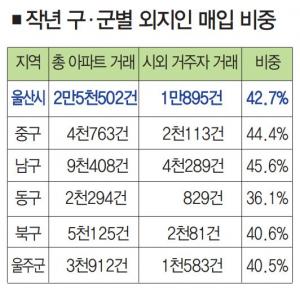42.7% of apartment transactions appear as foreigners’ purchases. Share of purchases by gu/gun South> Middle> Buk-gu> Ulju-gun> Dong-gu
—
Amid a sharp rise in house prices in Ulsan, two out of five local apartment traders last year were found to be out of town.
It is analyzed that when foreigners flock to avoid regulation and buy apartments, the local residents, stimulated by this, joined the purchase procession and house prices continued to rise throughout the year.
On the 28th, an analysis of the apartment sales transaction by buyer’s residence of Korean real estate revealed that 42.7% (10,895) of the total 25,000 apartment transactions in Ulsan last year were outsiders’ purchase transactions.
Compared to the previous year (40.9%), this ratio increased by 1.8%p.
By ward and county, the share of purchases from outsiders in Nam-gu was the highest at 45.6%, followed by Jung-gu 44.4%, Buk-gu 40.6%, Ulju-gun 40.5%, and Dong-gu 36.1%.
Last year, in Ulsan, the so-called’balloon effect’ caused by the adjustment of the area subject to adjustment in neighboring regions along with the effect of supply shortages, and apartment prices rose the most in nine years.
The annual apartment sale price in Ulsan rose 10.50% last year, recording the highest increase since 2011 (16.41%). Jung-gu and Nam-gu were included in the government’s additional designation of regulated areas at the end of the year, but it was not enough to break the uptrend.
Jeong Soon-geun, director of The Gam-dong real estate agent, said, “The overheating of house prices is linked to speculative demand from outsiders. Last year, the overheating of house prices in Ulsan was aggravated as outsiders initiated and end-users, local residents, added’panic buying’ (panic purchase).”
“Since October 2019, one group of foreign investors started buying new apartments in Ulsan, such as Munsu-ro I-Park, and in February and May of last year, the second and third teams bought semi-new and built apartments, “It has greatly increased the price of apartments,” he said. “From this year onwards, the transaction volume of local residents is expected to increase as apartments bought by foreign investors are sold back to end-users, Ulsan citizens. “There is no sign of any adjustments to the soaring Ulsan house prices, and as supply shortages continue, indigenous peoples who want to live will be trading apartments.”
According to real estate information company Asil, only 2,736 households were supplied to Ulsan from January last year to December 2022.
Considering that the number of housing needs in Ulsan per year is 5,680 households, it is less than a fifth of the supply. Accordingly, the rise in apartment prices due to supply shortages is not expected to decline significantly this year.
On the other hand, in addition to Ulsan, there were 17 cities (city) where apartment prices increased by more than 10% last year, and 15 of them had a higher proportion of foreigners’ transactions than the previous year.
Sejong City, which had the highest rate of increase in apartment prices last year at 44.93% in the country, fell 1.6%p from 47.0% last year to 45.4% last year, and Hanam City (66.7% → 5
6.5%) and the proportion of foreigners’ transactions decreased. Reporter Kim Ji-eun
Copyright holder © Ulsan Jeilbo Unauthorized reproduction and redistribution prohibited
–

![The late Song Yoo-jeong’s agency, Subraim artist, “Session for defamation of Ka Se-yeon” [공식] The late Song Yoo-jeong’s agency, Subraim artist, “Session for defamation of Ka Se-yeon” [공식]](https://spnimage.edaily.co.kr/images/Photo/files/NP/S/2021/01/PS21012800117.jpg)